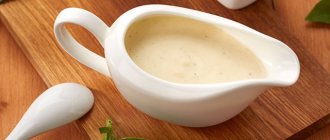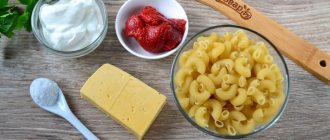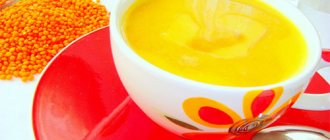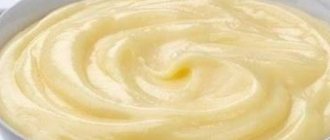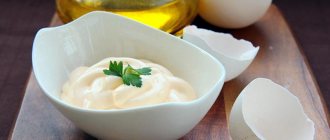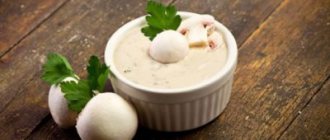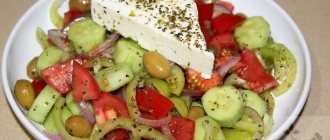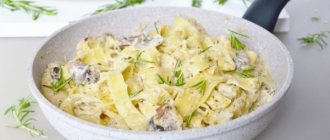It has already become a habit, and even a stereotype, that sauce is something that needs to be generously poured over food, otherwise it is impossible to eat it. It's rare that the understanding of sauce is more than mayonnaise from the nearest supermarket or ketchup from a packet. However, one of my friends claimed that the best sauce for sauce is ketchup, mayonnaise and in equal proportions, until he tried cucumber sauce, garlic and sour milk.
Generally speaking, sauce or gravy is a fairly thick seasoning, an addition to dishes (usually main dishes). The purpose of the sauce is to give the dish juiciness and richness, and, often, increase nutritional value. In addition, indirectly, the sauce performs an additional function of improving the appearance of the dish. The sauce is often not only served with the main dish, but can also be used to prepare the dish itself. Eg, . In the Pacific Islands, dishes of meat and vegetables stewed in coconut milk are very popular, with the coconut milk then acting as a sauce, or using herbs.
The thickness of the sauce usually varies greatly depending on the dish, and the same sauce can be very thin or very thick. Liquid sauce base: from ordinary water to very complex or exotic compositions. The so-called “additional part” is chopped products (meat, fish, cheeses, vegetables, mushrooms, etc.), spices, and other additives. Quite often, sauces are made additionally thick by adding flour and starch.
Cucumber sauce is found in French cuisine. It is customary to distinguish several types of “basic” sauces. They either stand alone or are used as a base for the preparation of more complex “derivative sauces”.
Surely everyone has heard about bechamel, espagnole, and veloute sauces. These are the main sauces. By the way, regular tomato sauce and mayonnaise are also basic sauces.
A separate category of sauces is dressings, or salad dressings. Perhaps the most famous salad dressing is vinaigrette. This is a mixture of olive (Provencal) oil and wine vinegar. However, regular vegetable oil is usually used for salad dressing. Another well-known salad dressing is sour cream, or thick fermented milk products. And no one bothers you to add additional ingredients to the dressing - lemon or orange juice, herbs, grated cheese.
Oriental cucumber sauce tzatziki (dzhadzhik, tzatziki, tzatziki - and many more pronunciation options). Tzatziki is believed to be a Greek sauce. I won't argue, maybe that's true. But I have tried variations of this sauce in many countries of the East, the Balkans and the Mediterranean. And everywhere, local residents are convinced that their people are the founders of this dish. Greek tzatziki is more of an appetizer than a sauce. Although the consistency can be anything. In Bulgaria, fermented milk okroshka is almost similar in recipe to tzatziki. They are different from the one we love. In the summer heat on the Black Sea coast in Bulgaria, I personally love to eat a plate of ice-cold tarator. A thicker version, almost a snack with a composition similar to tzatziki, is quite often found in Turkey - dzhadzhik (Turkish cacik). In Bulgaria, too, “” is very popular - thick, like pate, made from sour milk.
Today we will prepare cucumber and garlic sauce based on homemade sour milk, using most of the ingredients inherent in tzatziki.
Sour milk recipes
1. Homemade cottage cheese
If you have 1.5-2 liters of milk left, you can make wonderful cottage cheese. It will yield approximately 200 - 400 g. To do this you will need sour milk, two saucepans for a water bath, a colander and gauze. Pour the milk into a smaller saucepan and place it in a water bath. When the water boils, watch the milk. The milk will begin to curdle, separating into flakes and whey.
It is important not to overheat the milk, otherwise the cottage cheese will turn out dry. Once the whey has separated, remove the pan from the milk and set aside. Drain the resulting mixture into a colander lined with gauze and wait until it cools. When the liquid has drained, wrap the curd in cheesecloth and hang until the whey stops dripping.
2. Delicious pastries
You can prepare many delicious dishes from sour milk: fluffy pancakes, pancakes, pies, bread. The dough made with sour milk turns out airy and rises quickly. We recommend pancakes with sour milk.
Ingredients:
Milk 500 ml. Wheat flour 1 cup Chicken egg 2 pcs. Soda 1/2 tsp. Salt, sugar to taste
Add eggs and salt to milk. sugar, soda and whisk. Add flour and stir until the consistency of thick sour cream. There is one secret here - the flour must be mixed so that the dough remains lumpy.
When the dough is ready, place the bowl of dough in a pan of hot water (not boiling water), cover with a towel and leave for 15 minutes. Heat the oil in a frying pan and fry the pancakes. Do not stir the dough - just scoop it with a spoon and place it in the pan.
3. Marinate the meat
Lactic acid, acting on the fibers of meat, makes it unusually tender. In the Caucasus, meat has long been marinated in sour milk, and Georgian kebab is considered the most delicious. You can use any meat and any spices.
The simplest recipe is meat, onions, salt, pepper and sour milk. Salt and pepper the meat, cut the onion into rings. Place the meat and onions in a bowl, pour in sour milk to cover all the meat and refrigerate for at least 2 hours. Fry on skewers or in a frying pan and enjoy the tasty and tender meat.
What to make from sour milk?
Any housewife will be upset to find spoiled food on the shelf in the refrigerator. If this trouble occurs with meat products, eggs or ready-made dishes, you will have to mercilessly part with them. But you don’t have to worry about sour milk: it will become the basis for many dishes.
Pie dough
Dilute 10 g of yeast with 1 tsp of sugar in 100 grams of water.
Add half a liter of sour milk; 800 grams all-purpose flour; 2 eggs; 5 tablespoons of vegetable oil; Add 1 teaspoon salt and knead until you get a sticky dough.
After an hour and a half, when the dough has increased in volume, form the pies. You can use any food from your refrigerator as a filling.
Sour milk cake
Try making a cake under the intriguing name Count's Ruins.
Two cakes of different colors are baked. For a white cake you will need: half a glass of sour milk; 1 glass of flour; half a glass of sugar; 1 egg; one pinch of soda. A white cake is baked from these products. For the second cake you will need: 1.5 tbsp. sour milk; 3 cups flour; 1.5 tbsp. Sahara; 3 tbsp. l cocoa powder; 3 eggs; 2 tsp soda. A brown cake is baked, which after cooling is crumbled into small pieces. Pieces of brown cake are placed on a white cake layer, filled with cream and cooled for several hours in the refrigerator.
The cream is prepared from 1 liter of sour cream and 2 cups of sugar, mix everything well.
Soup "Tator"
You can also please your household with unusual recipes by preparing them dishes made from sour milk.
Tarator soup has been a staple of Bulgarian cuisine for many centuries. To prepare it you will need: 3 cucumbers; 5 boiled eggs; 3-5 cloves of garlic; greens (parsley, basil, dill, cilantro); 2 tbsp. l sunflower oil; salt - to taste. Cucumbers can be chopped with a knife, grated, eggs and herbs can be chopped. All ingredients are poured into a deep plate and filled with sour milk. This soup will perfectly fill and cool you on a hot summer day.
Summer snack
Ukrainian national cuisine also knows what to make from sour milk.
If you have fresh tomatoes, you can make an interesting appetizer. Green lettuce leaves are laid out on a dish or large flat plate, with tomatoes cut into two parts on top. Everything is covered with fermented milk sauce. The sauce is prepared as follows: add 2 cloves of garlic and chopped horseradish root to sour milk (0.5 cup is enough). Beat everything with a mixer. A teaspoon of mustard added to it will add a touch of piquancy to the sauce.
Curd made from sour milk
Almost no effort is required to make cottage cheese at home.
Place the container with the acidic product in the microwave for 2 minutes (can be heated on the stove). The curdled mass is filtered through multi-layer gauze or linen napkin.
Ready cottage cheese can be consumed as a dish on its own, or can be used for making cheesecakes and casseroles. The whey will also come in handy: it will make amazing pancakes and pancakes.
Use of sour milk
4. Use as cosmetics
Do you think sour milk is used only in cooking? It can also be used for skin and hair care. Milk improves skin texture and tone, penetrates and moisturizes cells, relieves flaking and promotes collagen formation. Try using it for daily washing, for baths, preparing compresses, cosmetic masks and simply for wiping your face.
We offer you a recipe for a mask for weakened and damaged hair:
1 glass of sour milk 2 tbsp. l olive oil 2 drops lavender essential oil 2 drops rosemary essential oil
Soak the hair well along the entire length, cover your head with a bag and a towel, and leave for 30-40 minutes. Then wash off with shampoo.
5. For pets
Sour milk is a nutritious product not only for humans. Pour a little milk into your pet's food and they'll get an extra dose of protein and calcium.
Hot sauce based on fermented milk products with herbs and spices is very popular in Caucasian cuisine. In Armenian cuisine it is called skhtor-matsun and is prepared on the basis of matsun - an analogue of yogurt, kumiss, ayran, matsoni, katyk - every national cuisine has a product made from fermented milk) with the addition of garlic. Since it takes several days to prepare matsun, I follow a simple path - from ordinary kefir or sour cream I make a simple but very tasty garlic sauce with spices. A similar Georgian sauce is prepared with matsoni. The Ossetian sauce Tsakhton is very similar to this recipe. We are accustomed to calling this sauce tsakhton. Along with tsakhton, my family really loves Georgian and Greek. All recipes of Caucasian cuisine
By .
Compound:
- Sour cream – 250 grams
- Water – 3 tablespoons (optional)
- Spicy greens – cilantro, basil, dill, tarragon
- Coriander – 1/2 teaspoon
- Salt – 1/3 teaspoon
- Ground black pepper – 1/2 teaspoon
- Garlic – 2-3 cloves
- Dried herbs, spice mixture - 1/2 teaspoon
How to prepare a spicy fermented garlic sauce with fresh herbs based on the Caucasian sauces tsakhton, skhtor-matsun and matsoni
To prepare tsakhton sauce, you can leave the consistency of sour cream. But I like to pour sauce over the dish, so I dilute the sour cream with water. Or I prepare the sauce with kefir; there is no need to dilute it. Chop the greens - fresh cilantro, basil, dill. Finely chop the garlic.
Prepared fresh herbs and garlic
Prepare the required amount of pepper, coriander, a mixture of spices (you can use a ready-made mixture like hops-suneli, I used dried marjoram, mint, thyme, paprika).
Prepared spice mixture
Add to the fermented milk base, stir well.
Cover with a lid and place in the refrigerator overnight. The next day you will have a hot and spicy refreshing fermented milk sauce that will decorate almost any meat, fish, vegetable dish and goes well with fresh vegetables. It can be used as a marinade and seasoned on salads. Even ordinary Borodino bread or a piece of lavash with spicy garlic fermented milk sauce tsakhton is delicious, you can’t put it down.
Spicy garlic fermented milk sauce based on Caucasian cuisine with fresh herbs and spices is ready. Tsakhton sauce has only one drawback - no matter how much you make it, it always ends before the dish for which it is prepared.
And a small digression - my family has always prepared a simple sauce from kefir, fresh herbs, garlic and grated peeled fresh cucumber, which is immediately similar to both the tsakhton recipe given here and the Greek sauce. This sauce was called “purtush”. With the advent of the Internet, I looked for it in recipes of Armenian, Azerbaijani and Georgian cuisine and did not find it... If anyone came across it, please write, I will be very grateful, I’m curious where the name came from.
It's no secret that with a well-chosen and well-prepared sauce, almost all dishes become tastier. However, not all modern housewives agree to spend a lot of time and effort preparing gravy. They want to find a recipe that allows them to make a delicious sauce from available ingredients in a relatively short period of time. Such recipes exist. It is absolutely easy to prepare a completely universal and not too high-calorie sauce from milk, butter and flour. It belongs to classical cuisine and is considered the main sauce, that is, it can not only serve as gravy, but also be used to prepare other sauces and dishes. This sauce is universal: it can be used for baking or as a gravy for meat, fish, pasta, vegetables, and if prepared thick, it will become an excellent filling for donuts.
Cooking features
As already mentioned, the process of preparing milk sauce is not very difficult and does not take much time, but the housewife cannot do without knowing some of the subtleties.
- The amount of flour used in the recipe depends on how thick you want the sauce to be. To make a thick sauce, you need to take a third of a glass of flour per glass of milk, that is, about 50–60 g. If you want to get a medium-thick sauce, then for two glasses of milk it is enough to take two tablespoons of flour, this is about 30–35 g. For use As a gravy, a liquid sauce is most often made, for which take a heaped tablespoon of flour (about 20 g) for two glasses of milk. The amount of butter usually matches the amount of flour used, that is, for a liquid sauce you need 20 g of butter, for a medium-thick sauce - 40 g, for a thick sauce - 60 g of butter.
- To ensure that no lumps form in the sauce when preparing the sauce, the flour is initially calcined in a dry frying pan. This does not need to be done for long: as soon as the nutty aroma appears, remove the pan with flour from the heat. The cooled flour is transferred to a saucepan and proceed to the next stage of preparing the sauce.
- Milk is added to the sauce in small parts, each time whisking the contents of the saucepan until a homogeneous mass without lumps is formed.
- At the next stage, add butter cut into pieces. Once the butter has dissolved in the sauce, it is ready. However, even after this, you can add additional ingredients to it: herbs, seasonings, salt or sugar. In this case, you can cook the sauce a little longer.
- Some recipes call for thickening the sauce not with flour, but with eggs or starch. In this case, the technology will be slightly different. If egg yolks are used, the sauce is heated in a water bath or very low heat, while trying not to bring it to a boil. If the recipe specifies starch, then add it to the hot sauce after dissolving it in cool water.
- It is better not to use ingredients such as vinegar or lemon juice when preparing milk sauce, as the milk may curdle.
Milk sauce is most often used hot, pouring it over dishes before serving. For meat, the classic version of the sauce is most often used, for fish - sauce with garlic, for pasta - with cheese, and for desserts - sweet milk sauce.
How to make milk gravy: step by step recipe
Before proceeding with the preparation, it is worth noting that the ingredients are designed for medium thickness
. To get a liquid gravy, just reduce the amount of flour and butter by half.
- Dry the white flour. This is a kind of “secret” of successful milk gravy, which, alas, many people neglect. Pour two large spoons of flour into a heated frying pan
and dry it. In no case do not allow it to change color; only light frying is needed. Then cool it down. Calcined flour will save you from hated lumps and easily mix with any liquid. This will also remove the gummy taste from your gravy. - Once you're done with the flour, pour it into a saucepan or saucepan. Add salt and 1/4 of our milk to it.
- Stir until all the formed lumps disappear. Try to break them as they appear; the quality of the gravy depends on these actions.
- As soon as lumps stop forming, pour in the remaining milk. Cook for 6 minutes
over low heat. - Then add butter, mix well and boil.
Clarification "just in case"
Cooling means transferring the flour to another container rather than leaving it in a hot pan. This is a mistake that beginners often make.
Clarification "just in case"
The concept of “boil”, surprisingly, seems superficial to many. Therefore, I will clarify that you should bring the gravy to a boil and immediately turn it off, and not wait until it boils away.
Classic milk sauce recipe
- wheat flour – 20–120 g;
- butter – 20–120 g;
- milk – 0.5 l;
- nutmeg (optional) - on the tip of a knife;
- salt or sugar - to taste;
- greens (optional) - to taste.
Cooking method:
- Sift the flour and pour into the pan. The amount of flour is determined based on how thick the sauce you want to make. Most often, a medium-thick sauce is made, which requires about 40 g of flour.
- Place the frying pan with flour on the fire. Heat the flour, stirring, until a nutty smell appears.
- Remove the pan from the heat, pour the flour into the saucepan and wait a couple of minutes until it cools.
- Light a fire under the saucepan and start pouring milk into it in a thin stream, while whisking it.
- Cut the butter into thin slices and place them in a saucepan with the sauce. Stir to help it dissolve faster.
- Add salt or sugar, depending on what dish the sauce is being prepared for. If you do not plan to serve it with dessert, you can additionally add pepper and finely chopped or blended herbs. Nutmeg will add a pleasant aroma to the sauce.
- When the sauce has thickened sufficiently and the added salt or sugar has dissolved, remove the saucepan from the heat.
After this, the sauce can be immediately used for its intended purpose or poured into a saucepan and placed on the table so that guests can pour it over the dishes served to them themselves.
Milk sauce with ginger and garlic for fish
- flour – 20 g;
- butter – 20 g;
- milk – 0.25 l;
- parsley – 20 g;
- ginger root – 10 g;
- garlic – 1 clove;
- salt, pepper - to taste.
Cooking method:
- Peel and grate the ginger root.
- Pass the garlic through a press.
- Finely chop the parsley with a knife.
- Toast the flour until it acquires a nutty flavor. Remove from heat for a while.
- Return the pan with flour to the stove. Add milk in small portions. Don't forget to whisk it so that there are no lumps. If you still cannot avoid their formation, strain the sauce through a sieve and return to the stove.
- Add ginger, garlic, parsley, salt and pepper to the sauce. At the same time, put a piece of butter in it.
- Continue heating the sauce until the butter has dissolved. All this time it needs to be stirred.
Milk sauce prepared according to the given recipe will be a good addition to fish dishes.
Milk sauce with ginger and garlic
This sauce will enhance any fish dish, including steamed fish balls.
If in this recipe you replace wheat flour with oatmeal and butter with olive oil, you will get a dietary sauce that will add new flavors to steamed vegetables and meatballs.
- milk 1.5-3.5% fat – 250 ml;
- wheat flour – 20 gr.;
- butter – 20 gr.;
- ginger (peeled piece) – 10 g;
- garlic – 1 clove;
- parsley – 20 g;
- salt, red pepper - a pinch
- Grate the garlic and ginger, chop the parsley.
- Fry the flour in a dry frying pan until a delicate creamy color appears, pour in milk in portions. Grind thoroughly.
- Add butter, garlic, ginger, salt and pepper and parsley to thickened milk.
- As soon as it boils, pour it into a gravy boat.
White sauce with onions and mushrooms
- milk – 0.25 l;
- flour – 40 g;
- butter – 40 g;
- onions – 100 g;
- champignons – 100 g;
- salt, spices - to taste.
Cooking method:
- Peel and finely chop the onion.
- Wash and dry the mushrooms with a napkin. Cut them into small cubes.
- Melt the butter in a frying pan, add the onions and mushrooms and cook until the liquid released from the champignons has evaporated.
- In a clean frying pan, heat the flour for a minute. Pour milk into it in a thin stream, constantly whisking it with a whisk.
- Add mushrooms and onions to the sauce, stir.
- Cook until the sauce thickens sufficiently.
This sauce goes especially well with meat and vegetables. It can be made with only mushrooms or only with onions. In this case, the amount of mushrooms or onions can be increased by one and a half to two times relative to the amount specified in the recipe.
Julienne of poultry and mushrooms with baked milk sauce
What products will be needed for julienne:
- boiled poultry meat - 300 gr. (for example, one boiled leg);
- champignons - 400 gr;
- onions - 2 pieces;
- vegetable oil - two tablespoons;
- butter - two tablespoons;
- flour - two tablespoons;
- baked milk - 500 ml;
- grated cheese - 100 g;
- bay leaf - 2 pieces;
- salt, pepper, nutmeg and parsley to taste.
Preparation:
- Peel the onion, cut into halves, each half into another half and chop finely. Clean the champignons from dirt and sand, cut off the edges of the legs, cut into slices. Cut the poultry meat into strips.
- Heat the oil in a frying pan, fry the onion until golden brown, add the mushrooms, one bay leaf and cook until the liquid has evaporated. Then add the poultry meat, salt and pepper.
- For the sauce, melt the butter in a saucepan and combine with flour. Prepare the gravy according to the classic recipe, only replace regular milk with baked milk.
- Place the mixture of meat and mushrooms in greased cocotte makers, pour in the sauce, pour cheese on top and place in the oven until the cheese melts and a crust forms.
Bon appetit!
As a summary, I would like to say: there are no irreplaceable ingredients in cooking. Each one can be replaced with something and the result is a completely new dish. It won't necessarily be worse than the original. Perhaps even tastier and healthier. But it will be just different. Therefore, if the recipe indicates that you need bechamel sauce, cook with bechamel.
Similar Recipes
Source: SauceBook.ru
Milk sauce with cheese
- milk sauce prepared according to the classic recipe – 0.3 l;
- hard cheese – 50 g;
- butter – 20 g;
- broth – 100 ml.
Cooking method:
- Boil the broth and mix it with the sauce. Heat the resulting mixture over low heat.
- Finely grate the cheese and add it to the sauce. Warm the sauce, stirring until the cheese has dissolved.
- Remove the sauce from the stove, add a piece of softened butter to it, and beat with a blender.
This sauce goes well with potatoes, pasta, and vegetable casseroles, giving them a creamy, cheesy taste.
Nutritious milk sauce with cheese
The taste of milk sauce can be enriched with egg or cheese. The result is a tasty and nutritious seasoning that can be used not only as an addition to porridge, noodles, and salads.
Cheese sauce is successfully used in vegetable salads. To prepare it, use ready-made milk sauce. Other Ingredients:
- Milk sauce – 650 g;
- Hard cheese – 100 g;
- Broth – 250 ml;
- Butter – 50 g.
To prepare the seasoning proceed as follows:
- Heat the broth without boiling (40 – 45 ºC).
- Mix the hot broth with the prepared sauce.
- The cheese is grated on a fine grater and added to the hot mixture, mixed thoroughly.
- After cooling, add soft butter and beat with a blender.
Sweet milk sauce
- milk – 0.5 l;
- flour – 30 g;
- butter – 30 g;
- sugar – 60 g;
- vanillin - on the tip of a knife;
- cinnamon (optional) - a pinch.
Cooking method:
- Boil the milk and add sugar to it. Wait for it to dissolve. Cool to room temperature.
- Fry the flour until caramel-colored and pour the milk into it in a thin stream, whisking it constantly.
- Add vanilla, cinnamon and thinly sliced butter.
- Continue heating the sauce, stirring until it reaches an even thick consistency. During this time the butter should completely melt.
This sauce can be poured over cheesecakes, pancakes or pancakes. If you want to use it as a filling, you need to use 4 times more flour and butter when cooking.
Milk sauce is a universal seasoning that can be served with side dishes, meat and fish dishes, and even desserts. It is prepared quickly and from available products. Even an inexperienced housewife can master the technology of making sauce.
It has already become a habit, and even a stereotype, that sauce is something that needs to be generously poured over food, otherwise it is impossible to eat it. It's rare that the understanding of sauce is more than mayonnaise from the nearest supermarket or ketchup from a packet. However, one of my friends claimed that the best sauce for sauce is ketchup, mayonnaise and in equal proportions, until he tried cucumber sauce, garlic and sour milk.
Generally speaking, sauce or gravy is a fairly thick seasoning, an addition to dishes (usually main dishes). The purpose of the sauce is to give the dish juiciness and richness, and, often, increase nutritional value. In addition, indirectly, the sauce performs an additional function of improving the appearance of the dish. The sauce is often not only served with the main dish, but can also be used to prepare the dish itself. Eg, . In the Pacific Islands, dishes of meat and vegetables stewed in coconut milk are very popular, with the coconut milk then acting as a sauce, or using herbs.
The thickness of the sauce usually varies greatly depending on the dish, and the same sauce can be very thin or very thick. Liquid sauce base: from ordinary water to very complex or exotic compositions. The so-called “additional part” is chopped products (meat, fish, cheeses, vegetables, mushrooms, etc.), spices, and other additives. Quite often, sauces are made additionally thick by adding flour and starch.
Cucumber sauce is found in French cuisine. It is customary to distinguish several types of “basic” sauces. They either stand alone or are used as a base for the preparation of more complex “derivative sauces”.
Surely everyone has heard about bechamel, espagnole, and veloute sauces. These are the main sauces. By the way, regular tomato sauce and mayonnaise are also basic sauces.
A separate category of sauces is dressings, or salad dressings. Perhaps the most famous salad dressing is vinaigrette. This is a mixture of olive (Provencal) oil and wine vinegar. However, regular vegetable oil is usually used for salad dressing. Another well-known salad dressing is sour cream, or thick fermented milk products. And no one bothers you to add additional ingredients to the dressing - lemon or orange juice, herbs, grated cheese.
Oriental cucumber sauce tzatziki (dzhadzhik, tzatziki, tzatziki - and many more pronunciation options). Tzatziki is believed to be a Greek sauce. I won't argue, maybe that's true. But I have tried variations of this sauce in many countries of the East, the Balkans and the Mediterranean. And everywhere, local residents are convinced that their people are the founders of this dish. Greek tzatziki is more of an appetizer than a sauce. Although the consistency can be anything. In Bulgaria, fermented milk okroshka is almost similar in recipe to tzatziki. They are different from the one we love. In the summer heat on the Black Sea coast in Bulgaria, I personally love to eat a plate of ice-cold tarator. A thicker version, almost a snack with a composition similar to tzatziki, is quite often found in Turkey - dzhadzhik (Turkish cacik). In Bulgaria, too, “” is very popular - thick, like pate, made from sour milk.
Today we will prepare cucumber and garlic sauce based on homemade sour milk, using most of the ingredients inherent in tzatziki.
Secrets of milk gravy and what to serve it with
Depending on what dish it is intended for, in your plans, the recipe can be improved. For dessert, just replace salt with sugar. If you plan to serve it with fish or meat, you can add pepper and chopped herbs. To add a subtle flavor to the dish, try adding chopped nutmeg; it often comes in handy.
Remember that everyone has their own tastes and it is better to serve gravy to guests separately from the dish.
It has already become a habit, and even a stereotype, that sauce is something that needs to be generously poured over food, otherwise it is impossible to eat it. It's rare that the understanding of sauce is more than mayonnaise from the nearest supermarket or ketchup from a packet. However, one of my friends claimed that the best sauce for sauce is ketchup, mayonnaise and in equal proportions, until he tried cucumber sauce, garlic and sour milk.
Generally speaking, sauce or gravy is a fairly thick seasoning, an addition to dishes (usually main dishes). The purpose of the sauce is to give the dish juiciness and richness, and, often, increase nutritional value. In addition, indirectly, the sauce performs an additional function of improving the appearance of the dish. The sauce is often not only served with the main dish, but can also be used to prepare the dish itself. Eg, . In the Pacific Islands, dishes of meat and vegetables stewed in coconut milk are very popular, with the coconut milk then acting as a sauce, or using herbs.
The thickness of the sauce usually varies greatly depending on the dish, and the same sauce can be very thin or very thick. Liquid sauce base: from ordinary water to very complex or exotic compositions. The so-called “additional part” is chopped products (meat, fish, cheeses, vegetables, mushrooms, etc.), spices, and other additives. Quite often, sauces are made additionally thick by adding flour and starch.
Cucumber sauce is found in French cuisine. It is customary to distinguish several types of “basic” sauces. They either stand alone or are used as a base for the preparation of more complex “derivative sauces”.
Surely everyone has heard about bechamel, espagnole, and veloute sauces. These are the main sauces. By the way, regular tomato sauce and mayonnaise are also basic sauces.
A separate category of sauces is dressings, or salad dressings. Perhaps the most famous salad dressing is vinaigrette. This is a mixture of olive (Provencal) oil and wine vinegar. However, regular vegetable oil is usually used for salad dressing. Another well-known salad dressing is sour cream, or thick fermented milk products. And no one bothers you to add additional ingredients to the dressing - lemon or orange juice, herbs, grated cheese.
Oriental cucumber sauce tzatziki (dzhadzhik, tzatziki, tzatziki - and many more pronunciation options). Tzatziki is believed to be a Greek sauce. I won't argue, maybe that's true. But I have tried variations of this sauce in many countries of the East, the Balkans and the Mediterranean. And everywhere, local residents are convinced that their people are the founders of this dish. Greek tzatziki is more of an appetizer than a sauce. Although the consistency can be anything. In Bulgaria, fermented milk okroshka is almost similar in recipe to tzatziki. They are different from the one we love. In the summer heat on the Black Sea coast in Bulgaria, I personally love to eat a plate of ice-cold tarator. A thicker version, almost a snack with a composition similar to tzatziki, is quite often found in Turkey - dzhadzhik (Turkish cacik). In Bulgaria, too, “” is very popular - thick, like pate, made from sour milk.
Today we will prepare cucumber and garlic sauce based on homemade sour milk, using most of the ingredients inherent in tzatziki.
Cucumber sauce. Step by step recipe
Ingredients (2 servings)
- Sour milk 0.5 cups
- Garlic 1 clove
- Cucumber 1 piece
- Fresh mint 1 sprig
- Dill 3-4 sprigs
- Arugula To taste
- Salt, black pepper, sweet paprika, dry herbs, olive oil To taste
- The sour milk is perhaps the most difficult part of the recipe, although the cucumber sauce is an easy dish.
When I was little, milk was almost always sour. It was quite difficult to buy milk in the store in time to bring it home, and it would not curdle when boiled. I remember how my mother, before boiling store-bought milk, always heated a little milk in a spoon. And only after checking, did I put the milk to boil. Now the milk does not want to turn sour at all. Even outside the refrigerator. However, you can always choose a reputable producer whose milk behaves like milk. Recently, normal yogurt and excellent sour milk have appeared on sale. By the way, it is a very useful product, unlike kefir of unknown composition and production method. Ingredients for fermented milk sauce - Cucumber - fresh, green, young.
Peel the cucumber and make sure there is no bitter taste. The cucumber must be finely chopped so that the cucumber sauce has small pieces that are barely perceptible. Do not grate, but cut into small cubes. Place the sliced cucumber in a small bowl or bowl. Chop a few fresh mint leaves and add to the cucumber. Salt and pepper. I advise you to add a pinch of dry aromatic herbs (basil, oregano) and, if desired, a pinch of sweet ground paprika. I mix all the spices and grind them in a mortar so that it is homogeneous. Mix the ingredients of the garlic sauce with the cucumber and leave for 5 minutes. Peel the cucumber and make sure there is no bitter taste. The cucumber should be finely chopped - Dill - only green leaves (stems are coarse and should not be used), chop with a knife.
Grate the garlic onto a fine grater. Add everything to the cucumbers. Add a quarter teaspoon of olive oil and stir. Next, add half of the arugula leaves, tearing them with your hands (do not cut them with a knife). Stir and start adding sour milk. The amount of sour milk is to taste. Dilute the cucumber sauce with sour milk to the desired consistency. Stir and start adding sour milk. The amount of sour milk is to taste. Dilute with sour milk to desired consistency
Milk sauce is not complicated, tasty, versatile and low in calories. French “white roux” easily replaces many other sauces and goes equally well with salty (meat, fish) and sweet (desserts, casseroles) dishes.
Milk sauce can become:
- gravy for dishes;
- base for other sauces;
- binding component in minced cutlets;
- donut filling;
- filling for rice and casseroles.
Attention! Milk sauce tastes much better hot than cold.
Cucumber sauce
It has already become a habit, and even a stereotype, that sauce is something that needs to be generously poured over food, otherwise it is impossible to eat it. It's rare that the understanding of sauce is more than mayonnaise from the nearest supermarket or ketchup from a packet. However, one of my friends claimed that the best sauce for sauce is ketchup, mayonnaise and mustard in equal proportions, until he tried cucumber sauce, garlic and sour milk.
Generally speaking, sauce or gravy is a fairly thick seasoning, an addition to dishes (usually main dishes). The purpose of the sauce is to give the dish juiciness and richness, and, often, increase nutritional value. In addition, indirectly, the sauce performs an additional function of improving the appearance of the dish. The sauce is often not only served with the main dish, but can also be used to prepare the dish itself. For example, meatballs are minced meat balls stewed in sauce. In the Pacific Islands, dishes of meat and vegetables stewed in coconut milk are very popular, with the coconut milk then acting as a sauce, or a green herbal sauce.
The thickness of the sauce usually varies greatly depending on the dish, and the same sauce can be very thin or very thick. Liquid sauce base: from ordinary water to very complex or exotic compositions. The so-called “additional part” is chopped products (meat, fish, cheeses, vegetables, mushrooms, etc.), spices, herbs and other additives. Quite often, sauces are made additionally thick by adding flour and starch.
Cucumber sauce is found in French cuisine. It is customary to distinguish several types of “basic” sauces. They either stand alone or are used as a base for the preparation of more complex “derivative sauces”.
Surely everyone has heard about bechamel, espagnole, and veloute sauces. These are the main sauces. By the way, regular tomato sauce and mayonnaise are also basic sauces.
A separate category of sauces is dressings, or salad dressings. Perhaps the most famous salad dressing is vinaigrette. This is a mixture of olive (Provencal) oil and wine vinegar. However, regular vegetable oil is usually used for salad dressing. Another well-known salad dressing is sour cream, or thick fermented milk products. And no one bothers you to add additional ingredients to the dressing - lemon or orange juice, herbs, grated cheese.
Oriental cucumber sauce tzatziki (dzhadzhik, tzatziki, tzatziki - and many more pronunciation options). Tzatziki is believed to be a Greek sauce. I won’t argue, maybe that’s true. But I have tried variations of this sauce in many countries of the East, the Balkans and the Mediterranean. And everywhere, local residents are convinced that their people are the founders of this dish. Greek tzatziki is more of an appetizer than a sauce. Although the consistency can be anything. In Bulgaria, fermented milk okroshka is called tarator, the recipe is almost similar to tzatziki. They are different from the kvass-based okroshka that we love. In the summer heat on the Black Sea coast in Bulgaria, I personally love to eat a plate of ice-cold tarator. A thicker version, almost a snack with a composition similar to tzatziki, is quite common in Turkey - dzhadzhik (Turkish cacik). In Bulgaria, too, “milky salad” is very popular - thick, like pate, made from sour milk.
Today we will prepare cucumber and garlic sauce based on homemade sour milk, using most of the ingredients inherent in tzatziki.
Cooking features
- Density.
- The sauce will be thick at a ratio of 3 tbsp. flour and 60 gr. butter for 150-170 ml of milk;
- medium - with a ratio of 3 tbsp. flour and 40 gr. butter for 150-170 ml of milk;
- liquid - at a ratio of 3 tbsp. flour and 20 gr. butter for 150-170 ml of milk.
- Thickeners.
This is usually flour or starch. Flour should be fried without oil or fried in oil before adding to the sauce - this prevents the appearance of lumps and the appearance of a nutty aroma.
Flour calcined without oil can be stored for future use. It should be stored in jars with a ground-in lid in a dry place.
Starch is not subjected to heat treatment; it is dissolved in 1-3 tablespoons of cooled boiled water and poured into the sauce.
You can thicken milk sauce not only with flour or starch, but also with egg yolk. You cannot boil the sauce when adding them; ideally, it should be cooked in a water bath.
- Milk and butter.
Fresh milk is most often used. You need to add it to the sauce a little at a time, whisking the sauce after each introduction. Some recipes use sour milk or coconut milk.
The butter will melt better and faster if it is at room temperature (lying on the table), but you should not melt the butter specifically for the sauce.
- Supplements
When adding spices and spices, the sauce is transformed.
The milk sauce mutes the harshness and heat of the spices. It softens their taste even with significant additions.
Good options are achieved by adding:
- in salty sauce - black pepper or paprika, nutmeg or ginger, dill or sesame seeds, cumin or bay leaf, turmeric or tomato paste, salt.
- for sweet - cinnamon, vanilla, cocoa, sugar.
Adding lemon juice can curdle the sauce!
The sauce presented in the basic recipe is suitable for people on any medical diet, children, pregnant and lactating women, etc. Its composition is the same as in kindergarten.
This sauce is very close to the French "", the recipe for which can be found here.
In its classic version, the sauce is good for fish, chicken and vegetables. You can use it to fill potato croquettes, and add sugar to donuts and pancakes.
The sauce is neutral, so it will absolutely harmoniously absorb any of the additives listed above. Once you know this recipe, you can easily improvise.
Prepare:
- for liquid sauce: butter and flour - 1 tbsp each;
- for medium sauce: butter and flour - 2 tbsp each;
- for thick sauce: butter and flour - 2.5 tbsp each;
- milk (for any of the options) – 500 ml;
- salt (optional) - a pinch
Cooking steps:
- Fry the flour in a dry frying pan until a delicate creamy color appears. But you shouldn’t overcook until brown.
- Without removing the pan from the heat, rub the butter into the flour. Add salt.
- Add boiling milk in portions, thoroughly rubbing the sauce each time.
At this stage, you can add sugar and additives to the sauce, choosing from those listed above.
If lumps have formed in the sauce for some reason, break them up by passing through it with a submerged blender or mixer.
Sweet milk sauce
This is a sauce recipe according to GOST. It is prepared in kindergarten, and at home - to pour over pancakes, pancakes, cheesecakes, puddings or fruit salads.
If desired, you can add cinnamon to the composition, replace granulated sugar with honey, and replace butter with sesame oil.
Prepare:
- milk – 500 ml (or 375 ml milk and 125 ml water);
- wheat flour – 20 gr.;
- butter – 20 gr.;
- sugar - 60 gr.;
- vanilla - on the tip of a knife
Cooking steps:
- Melt the butter in a saucepan, rub in the flour and fry until soft and creamy.
- Add hot milk in portions, thoroughly rubbing the sauce each time.
- Wait until it boils and cook the sauce (reducing heat to low) for 8-9 minutes.
- Mix sugar with vanilla and a small amount of hot (previously boiled) water.
- Rub the sweet solution into the sauce and wait for another boil.
- Pour over the dish.
This nutritious sauce complements potatoes and vegetable casseroles, and goes well with pasta and rice. For spaghetti and pasta, it is generally ideal.
Prepare:
- classic milk sauce of medium thickness – 300 ml;
- chicken broth – 100 ml;
- hard/semi-hard cheese – 50 gr.;
- butter – 20 gr.
Cooking steps:
- Prepare the classic sauce according to the recipe above.
- Cook chicken broth.
- Stir the hot broth into the sauce in portions.
- Add the grated cheese and heat on the stove until the cheese is completely melted.
- Cool the sauce slightly, add butter and beat with an immersion blender.
Milk sauce for diet No. 5
Adding this universal sauce to diet No. 5 dishes (for people with gastrointestinal, liver and gallbladder problems) will make the menu not so boring. The recipe is suitable for small children (kindergarten age) and for those who are struggling with obesity and eat, roughly speaking, one cabbage leaf.
The original sauce is good for cheesecakes, casseroles, puddings and fruit slices. If you exclude sugar and vanillin from its composition, then it will suit any steamed dishes.
Prepare:
- milk – 50 ml;
- water – 50 ml;
- butter – 10 g;
- wheat or oat flour – 1 tsp;
- sugar – 1 tsp;
- vanillin - a pinch.
Cooking steps:
- Fry the flour in a dry frying pan until a delicate creamy color appears, grind with butter, pour in the milk little by little.
- Grind the mixture thoroughly and boil it for about 10 minutes.
- Dissolve sugar and vanillin in water, stir into the sauce and wait until it boils.
- Remove from heat and beat with a blender if necessary.
Those who were lucky enough to enjoy dishes with this gravy as a child know how harmoniously it goes with everything. It was served with everything: meatballs, cutlets, pasta, and was often used for baking. We can confidently say that this is one of the most versatile gravies that housewives often use. A classic milk gravy recipe is just the thing to take your dish to a new level of flavor.
Ingredients
- Full fat milk - 500 ml
- White flour - 2 tbsp. l.
- Butter - 60 g
- Salt - to taste
Milk sauce with onions and mushrooms
The sauce is good with meat and vegetable dishes.
The sauce can be prepared with only onions or only with mushrooms. In this case, the unwanted component (either onions or mushrooms) is removed from the composition, and the amount of the desired one is doubled (200 grams are taken instead of 100).
Prepare:
- milk 2.5-3.5% fat – 250 ml;
- wheat flour – 40 gr.;
- butter – 40 gr.;
- onion – 100 gr.;
- mushrooms (champignons) – 100 gr.;
- salt - a pinch;
- spices - optional.
Cooking steps:
- Chop the peeled onions and cleanly washed mushrooms into separate plates.
- Fry onion and mushroom pieces in oil. This can be done together or separately.
- Fry the flour in a dry frying pan until a delicate creamy color appears.
- Combine flour and milk, adding it in parts and rubbing each added portion until smooth.
- Combine thickened milk with onion and mushrooms. Wait until it boils and pour into a gravy boat.
This sauce will enhance any fish dish, including steamed fish balls.
If in this recipe you replace wheat flour with oatmeal and butter with olive oil, you will get something that will add new flavors to steamed vegetables and meatballs.
Prepare:
- milk 1.5-3.5% fat – 250 ml;
- wheat flour – 20 gr.;
- butter – 20 gr.;
- ginger (peeled piece) – 10 g;
- garlic – 1 clove;
- parsley – 20 g;
- salt, red pepper - a pinch
Cooking steps:
- Grate the garlic and ginger, chop the parsley.
- Fry the flour in a dry frying pan until a delicate creamy color appears, pour in milk in portions. Grind thoroughly.
- Add butter, garlic, ginger, salt and pepper and parsley to thickened milk.
- As soon as it boils, pour it into a gravy boat.
HOW TO MAKE BASIC WHITE SAUCE
1. This is a simplified and accelerated version of the sauce - easier than even from a bag. The quantity is given for 4 people. You will need 425 ml of milk , which can be pre-infused so that the sauce acquires a delicate taste (you need to put a bay leaf, mace, 10 whole peppercorns, a piece of onion and a few sprigs of parsley into a saucepan with milk. Bring the milk slowly to a boil, remove from heat and leave until cool to infuse. 2. It is very important that the milk is completely cold, otherwise the sauce will be lumpy. So let the milk cool completely. Strain it back into the pan, discarding any additives you infused it with .Then add 20 grams of flour and 40 grams of butter. Always use plain flour or flour for the sauce, but not pancake flour. 3. Gradually bring the sauce to the boiling point, stirring constantly with a whisk. The starch grains of the flour will disperse when boiling and become gelatinous. You need to constantly beat so that the flour is evenly distributed throughout the pan, and the sauce is thickened without lumps. In addition to constant whisking, there is one more rule: fat content. It is the flour mixed with fat that determines a homogeneous, tender sauce without lumps. Therefore, never try to mix flour with hot liquid without fat, you will end up with lumps. Everything is quite simple, and when you remember these rules, you won’t get any lumps. But if you suddenly forget and make a mistake, don’t worry - sieves were not invented by chance. 4. The sauce never looks thick enough when it first simmers. Don't panic, just be patient, lower the heat and stir over low heat for 5 minutes. Remember that even though you use flour as a thickener in the sauce, it also needs time to cook. The only exception is if you continue to prepare the sauce in the oven - for lasagna, for example. Then you need to reduce the time to 2-3 minutes. 5. If you want to make the sauce in advance, place cling film on the surface of the sauce - this will prevent “foam” from appearing on it. Then either keep it warm by placing it over a pan of slowly simmering water, or, if you want to make it much ahead, reheat it using the same method but without removing the cling film until the sauce is ready to be served. If the sauce thickens too much over time, add a little milk, broth or cream - the consistency will be the same. 6. Now you have a finished sauce, which opens the door to many more variations. Add some freshly squeezed lemon juice and chopped dill and serve the sauce with the fish, or chopped fresh parsley and serve with the fish cakes. You can make a lighter sauce using half milk and half stock - or even half wine or cider. And if you bake or boil smoked fish or other fish in milk, you can use half the milk and half the liquid the fish was cooked in - just make sure it's completely cold. Try these recipes:
> White sauce with variations > White sauces > Baked pike perch with potatoes in white sauce
Turkish sour milk sauce
The sauce goes well with vegetables - cucumbers, tomatoes, fried zucchini, salad. It's not bad with meat either. The main thing is not to over-salt it and not leave it for “tomorrow”, since the sauce has a short shelf life.
Prepare:
- sour milk – 250 ml;
- garlic – 1 clove;
- black pepper (ground) - on the tip of a knife;
- salt - a pinch;
- greens - optional.
Cooking steps:
- Pour the sour milk (yogurt) into a colander, at the bottom of which 3-4 layers of gauze are laid and leave for several hours.
- Mix the curd that remains after the whey has gone off with salt, pureed garlic and chopped herbs.
- Cover the mixture with a bowl and place in the refrigerator for 2-3 hours. All!
Asian coconut milk sauce
An interesting recipe for chicken, meat, fish dishes and vegetable salads. The sweetness and spiciness in it can be adjusted by increasing or decreasing the amount of spices, honey and seasonings.
Prepare:
- coconut milk (canned) – 100 ml;
- peanut oil - 100 gr.;
- sesame oil - 2 tsp;
- fresh lemon or lime juice - 1 tbsp;
- honey - 0.5-1 tsp;
- fish sauce - 2 tbsp;
- - 1 tbsp;
- curry paste - 1 tbsp;
- black pepper, cayenne pepper, cinnamon - 1 pinch each.
Cooking steps:
- Place all ingredients in a large bowl and combine with a blender.
- Transfer the homogeneous sauce into a gravy boat.
Coconut milk sauce from Michel Roux
The recipe was developed by a British chef specifically for fish, but the sauce also goes well with pasta.
Prepare:
- coconut milk (canned or fresh) – 400 ml;
- wheat flour – 30 gr.;
- butter – 30 gr.;
- soy sauce - 1 tbsp;
- garlic – 2 cloves;
- nutmeg (grated) – 1 pc.;
- white or black pepper – 1 pinch (you can do without them);
- salt – 1 pinch.
Additionally prepare:
- butter – 100 gr. (or drained butter - 20 g and cream - 80 ml);
- green chili pepper (for example, Jalapeño) – 20 gr.;
- red chili pepper – 10 gr.;
- shrimp (peeled) – 250 g (optional component, but highly desirable).
Cooking steps:
- Remove seeds from chili, remove peels from garlic, chop. Boil the shrimp.
- Fry the flour in a dry frying pan until a delicate creamy color appears, combine with coconut milk, grind, wait until it boils, add nutmeg, black/white pepper and salt to the sauce.
- Remove from heat, add garlic and soy sauce.
- Add chili to melted butter in a saucepan, heat and add shrimp.
- Wait until it boils and pour into a gravy boat.

